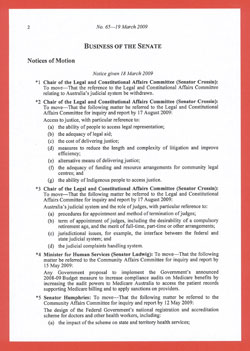80 Disposal of motions
-
Motions shall be called on in the order in which they appear on the Notice Paper.
-
If, at the adjournment of the Senate, a motion on the Notice Paper has not been called on, or has been moved but not determined, it shall be set down on the Notice Paper for the next sitting day.
Amendment history
Adopted: 19 August 1903 as SOs 110 and 111 (corresponding to paragraphs (1) and (2))
Amended: 2 December 1965, J.427 (to take effect 1 January 1966) (drafting amendment to replace “disappear” (see below) with “be withdrawn”) (superseded)
1989 revision: Old SOs 116 and 117 combined into one, structured as two paragraphs and renumbered as SO 80; some revision of language to ensure consistency with other standing orders and to conform to longstanding practice
Commentary

The Notice Paper shows the order in which motions will be called on
In its original form, SO 80 provided as follows:
Motions shall have precedence each day according to the order in which they appear on the Notice Paper, and if called on and not dealt with prior to the adjournment of the Senate shall disappear from the Notice Paper.
If, at the adjournment of the Senate, any Motions on the Notice Paper have not been called on, such motions shall be set down on the Notice Paper for the next sitting day, at the end of the regular Business of that day.
The current formulation of paragraph (1) is the result of the 1989 revision and provides a much clearer expression of what is really quite a simple concept: business is called on in the order in which it appears on the Notice Paper. The structure of the Notice Paper is already governed by a number of standing orders dealing with categories of business, the precedence given to certain categories at particular times, notices of motion, orders of the day, and the freedom given to ministers to arrange the order of government business on the Notice Paper as they see fit.[1] The interaction of these standing orders determines the order in which business appears on the Notice Paper.
The second half of the original first paragraph was redundant by 1914 when the Senate adopted a new standing order dealing with interrupted business (see SO 68). Debate on a motion could be adjourned and resumption of the debate made an order of the day for a subsequent day. If this did not occur, the terms of the original standing order meant that such motions lapsed. They literally “disappeared” from the Notice Paper. The Senate reversed this practice by adopting a standing order in 1914 to provide for interrupted business to remain on the Notice Paper for the next day of sitting. However, the adoption of a new standing order did not lead to any modification to the precursor to SO 80. Although redundant, it was amended by the 1965 review only to make the drafting more felicitous (by replacing “disappear” with “be withdrawn”), not to address the fundamental contradiction.
The 1989 revision of the second paragraph also removed a provision that was contrary to longstanding practice; namely, that a motion not reached on any day rolled over to the next sitting day but went to the end of the list of orders on the Notice Paper. The revision made explicit the practice of keeping orders in their relative positions on the Notice Paper.[2]
See SO 83 for the lapsing of motions called on but not moved.